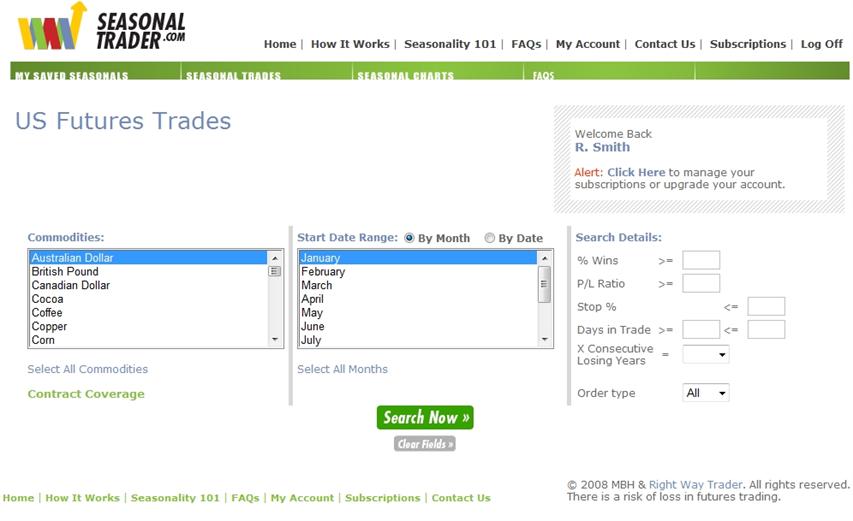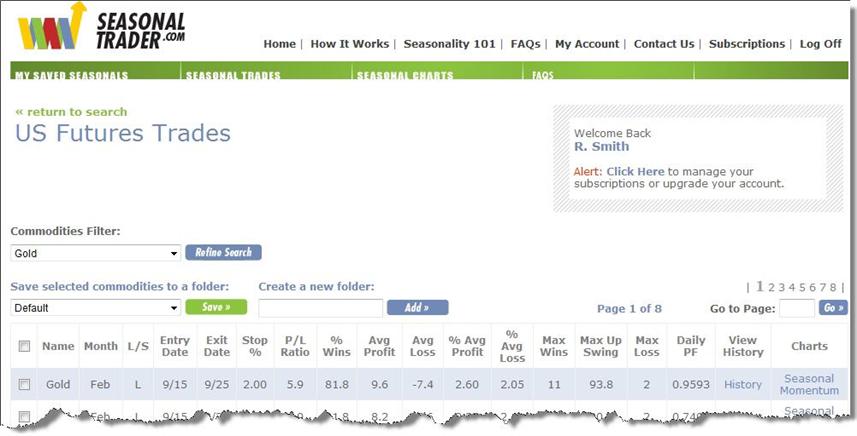
When you first log on to SeasonalTrader.com, you will typically find yourself at the Seasonal Trades query page for one of the modules that you are currently subscribed to. Here, for example, is a screenshot of the query page for trades in the US Futures:

Each module of SeasonalTrader.com has a single search page. All searching for trades in the given module is done from this search page.
Once you arrive at the search page, begin by selecting the market or markets that you would like to search. To select more than one market (or stock), hold down the Control (Ctrl) key while making your selections or just click and drag with your mouse to make contiguous selections.
Once you've selected the markets (or stocks) to search, the next set of options allow you to specify a range of dates for the start date of the trade. You can search for trades with start dates that fall within a certain month (or months) or on a specific date. The search options default to Search By Month. If you want to search a specific date instead, click in the By Date radio button and specify a date to search. The By Date option will return any trades that start on the given date.
Now that you've selected your contracts and your start date range, you can further refine your search via the following Search Detail fields.
The fields here that require a numerical input require whole number inputs. To filter for trades that have been winners 75% or more of the time then enter "75" in the % Wins field.
| Field | Description |
|---|---|
| % Wins | The % Wins filter allows you to limit your search results to only those trades that have been profitable X% or more of the time over their history. |
| P/L Ratio | The P/L Ratio filter allows to limit your search results to only those trades where the ratio between the cumulative profits and the cumulative losses (over the full history of the trade) is above a fixed ratio. |
| Stop | Set a maximum value for the stop that you wish to use on the trade. Stops for Commodities and Stocks are in percentages (e.g., 1, 2, etc.). Stops for Spreads are points and vary by spread. |
| Duration |
Set a minimum and/or a maximum value for the number of days that you wish to be in the trade. |
| Consecutive Losing Years | Here you can filter for trades that have been losing trades for the last 1, 2 or 3 years. If a trade has had a strong history of being a winning trade but has recently had a losing run, it may be overdue for a winning year. |
| Order Type |
Restrict the trades returned to only be trades where you are Long the market or trades where you are Short the market. |
Once you've entered all of the parameters for your search, click on the Search Now button at the bottom right of the page. After a short period of time (usually a minute or less), SeasonalTrader will display all of the trades found in the system that match your parameters.
For example, here arethe first few results for trades in Gold futures that begin in the month of January, have been winners 75% of the time or more, have a P/L ratio of 3 or higher and are less than or equal to 30 days in duration.

If there are more trades than will fit on one page then paging controls are available at the top and bottom of the page.
The trades are initially sorted so that the best trades in the system are at or near the top of the results. Our definition of the "best trades" are those with the highest % Wins, largest P/L ratio, largest average profit per trade and the smallest stop. You can resort your results by clicking on any of the column headers in the table of trades. Alternately clicking on a column header will toggle the sort between ascending and descending.
If you find that your search has returned too many trades for you to easily navigate, then it is best to refine your search by clicking on the "return to search" button at the top of the page and refining your initial parameters.
Let's briefly cover the meaning of each field on this page (note that fields may vary slightly within the different module types):
| Name | Definition |
|---|---|
| << return to search | This link allows you to return to the previous query page with all of your original parameters intact. |
| Commodities Filter | If you have searched on more than one contract, you can filter your results to focus on any one of the contracts that you searched on. Just choose the contract of interest from the Filter drop down menu and then click on the Refine Search button. |
| Save selected commodities ... | This drop down menu allows you to specify a folder in which to save your favorite trades in the My Saved Seasonals area. Select the desired folder from the drop down menu and then click on the Save >> button. All trades with check marks in the left hand check box will be saved to the selected folder. |
| Create a new folder | You can type in a new folder name here and the click on the Add >> button and it will created a new folder for saved trades under My Saved Seasonals. Once you've created a new folder you can then choose it from the Save selected commodities drop down menu and save trades to it. |
| Go to page | Navigate to a particular page of results. You can also click on the page numbers above Go to page |
| Name | The name of the futures contract type. |
| Month | This is the contract month for the given futures contract. The trades in the screen shot above take place in the February Gold futures contract. |
| L/S | Whether the trade is a Long trade or a Short sell. |
|
Entry Date |
The date on which to place the trade. Trades are assumed to be entered on the close of the given date. |
| Exit Date | The date on which the trade is exited if the trade has not been stopped out prior to this date. Exits are assumed to be on the close of the given date. |
| Stop % | All trades have an associated stop loss associated. Once a trade is entered, the stop loss can be calculated by multiplying the entry price by stop loss percent and then subtracting the amount from the entry price (or adding it to the entry price for Short trades). Stops are assumed to be close only stops. If the price closes below the stop (or above on a short trade) then exit the trade. Note that stops on spreads are in points. For more on spread stops see Stops on Spreads. Also note that some trades show a 100% stop loss. These trades do not use any stop loss and are best traded using an options strategy. |
| P/L Ratio | The P/L Ratio tells you the ratio of the cumulative profits to the cumulative losses over the history of the trade. A trade with a P/L Ratio of 3 has had 3 times more profits than losses. |
| % Wins | The % Wins tells you what percentage of the trades have been winners over the history of the trade. If a trade has 40 years of history and it has been profitable 30 out of 40 years then it has a P/L Ratio of 75%. |
| Avg Profit | The average profit over all the winning trades in the history of the trade. |
| Avg Loss | The average loss over all the losing trades in the history of the trade. |
| % Avg Profit | The average percentage profit (relative to entry price) for all of the winning trades in the history of the trade. |
| % Avg Loss | The average percentage loss(relative to entry price) for all of the losing trades in the history of the trade. |
| Max Wins | The longest streak of winning trades over the history of the trade. |
| Max Upswing | The maximum cumulative profits achieved by successive winning trades. |
| Max Loss | The longest streak of losing trades over the history of the trade. |
| Daily PF | The daily PF is the “daily profit factor”. This figure is only relevant when comparing several trades in SIMILAR MARKETS. In other words, in markets that have the same dollar value per tick. The higher the PF, the more money the trade has made, on average, on a daily basis. PF can help you decide between several trades in the same market that tend to occur at about the same time. |
| View History | Each trade has an associated History page that shows the full historical performance summary for the trade. For more on the History page see the History topic. |
| Charts - Seasonal | Clicking on the Seasonal link in the Charts column for a given trade will open up the Seasonal Chart for the associated contract, spread or stock. For more on Seasonal Charts visit the Seasonal Charts topic. |
Next Topic: History